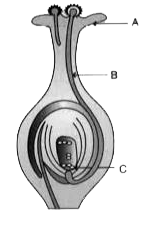(i) Give one example each of a unisexual and a bisexual flower.
(ii) Mention the changes a flower undergoes after fertilisation.
(iii) How does the amount of DNA remain constant though each new generation in a combination of DNA copies of two individuals?Solution in Kannada
(i) Unisexual flowers : Cucumber, pumpkin, water melon, papaya, etc.
Bisexual flowers : I libiscus, rose, lily, etc. (Any one example)
(ii) Changes in a flower after fertilisation : The outer layers of the ovule become impervious and hard and function as a seed coat. An ovule with an embryo inside is called a seed.
The ovary enlarges and ripens to become a fruit. Other floral parts such as sepals, petals, stamens, styles and stigma may fall off. However, in some cases, they remain persistent in the fruit.
(iii) Deoxyribonucleic acid (DNA) copying is an essential part of reproduction, as it passes genetic information from parents to offspring. The reproducing cells produce a copy of their DNA through some chemical reactions and result in two copies of DNA. The copying of DNA always takes place along with the creation of additional cellular structure. This process is then followed by the division of a cell into two cells. In this way, the amount of DNA remains constant through each new generation.
Topper's Solved these Questions
- HOW DO ORGANISMS REPRODUCE?BOOK - OSWAAL PUBLICATIONCHAPTER - HOW DO ORGANISMS REPRODUCE?EXERCISE - TOPIC - 3 (REPRODUCTION IN HUMAN BEINGS)(MULTIPLE CHOICE QUESTIONS)
2 Videos
- HOW DO ORGANISMS REPRODUCE?BOOK - OSWAAL PUBLICATIONCHAPTER - HOW DO ORGANISMS REPRODUCE?EXERCISE - TOPIC - 3 (REPRODUCTION IN HUMAN BEINGS)(MATCH THE COLUMN)
1 Videos
- HOW DO ORGANISMS REPRODUCE?BOOK - OSWAAL PUBLICATIONCHAPTER - HOW DO ORGANISMS REPRODUCE?EXERCISE - TOPIC - 2 (SEXUAL REPRODUCTION IN PLANTS)(SHORT ANSWER TYPE QUESTIONS - II)
17 Videos
- HEREDITY AND EVOLUTIONBOOK - OSWAAL PUBLICATIONCHAPTER - HEREDITY AND EVOLUTIONEXERCISE - NCERT CORNER TEXTBOOK EXERCISES
11 Videos
- LIFE PROCESSES BOOK - OSWAAL PUBLICATIONCHAPTER - LIFE PROCESSES EXERCISE - NCERT CORNER ( TEXTBOOK EXERCISES )
13 Videos
Similar Questions
Fertilization of ovum in human beings takes place in :
View SolutionMatch the Column

View SolutionName the parts A, B and C shown in the diagram and write their functions.

View SolutionA Mendelian experiment consisted of breeding tall pea plants bearing violet flowers with short pea plants bearing white flowers. The progeny all bore violet flowers, but almost half of them were short. This suggests that the genetic make up of the tall parent can be depicted as
View SolutionThe kidneys in human beings are a part of the system for
View Solution(a) What is meant by 'unisexual flowers' and 'bisexual flowers' ? Give two examples of each.
(b) What is pollination ? How does pollination occur ?
(c) Describe the process of fertilisation in a flower with the help of labelled diagrams.
(d) What changes take place in the flower after fertilisation which lead to the formation of seeds and fruit ?
View Solution(a) Give one examples each of the unisexual and a bisexual flower.
(b) Mention the changes a flower undergoes after fertilization.
(c ) How does the amount of DNA remain constant though each new generation which is a combination of DNA copies of two individuals?
View SolutionGive one example each of unisexual and bisexual flowers.
View SolutionGive one example each of unisexual and bisexual flowers
View SolutionDifferentiate between unisexual and bisexual flower. Give two examples of each .
View SolutionGive an example of a unisexual and bisexual flower.
View SolutionWhat is DNA copying and state its importance? OR How does the amount of DNA remain constant though each generation is a combination of DNA copies of two individuals?
View SolutionWhat is the effect of DNA copying, which is not perfectly accurate, on the reproduction process? How does the amount of DNA remain constant though each new generation is a combination of DNA copies of two individuals?
View SolutionExplain giving one example of each, the unisexual and bisexual flowers.
View Solution
